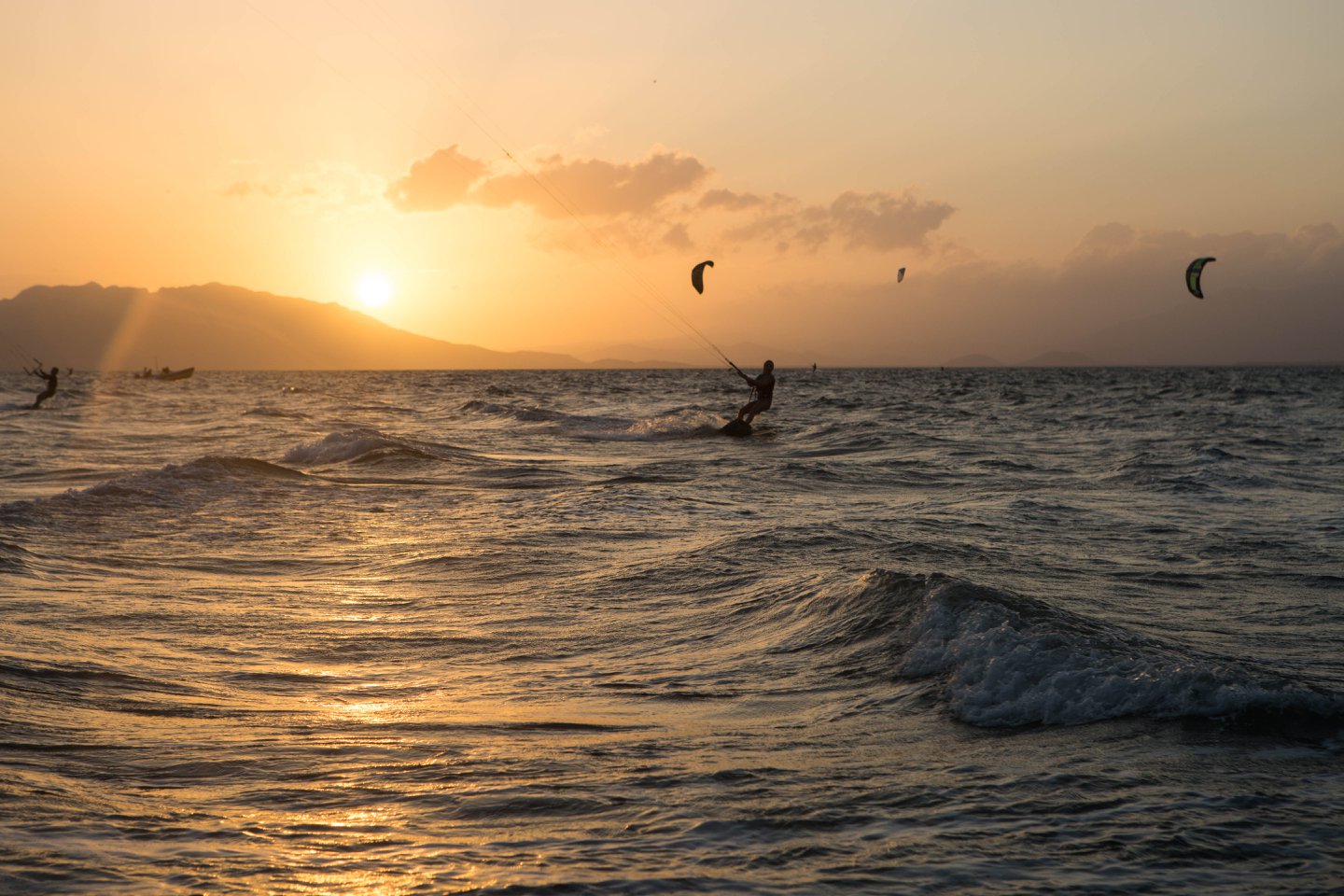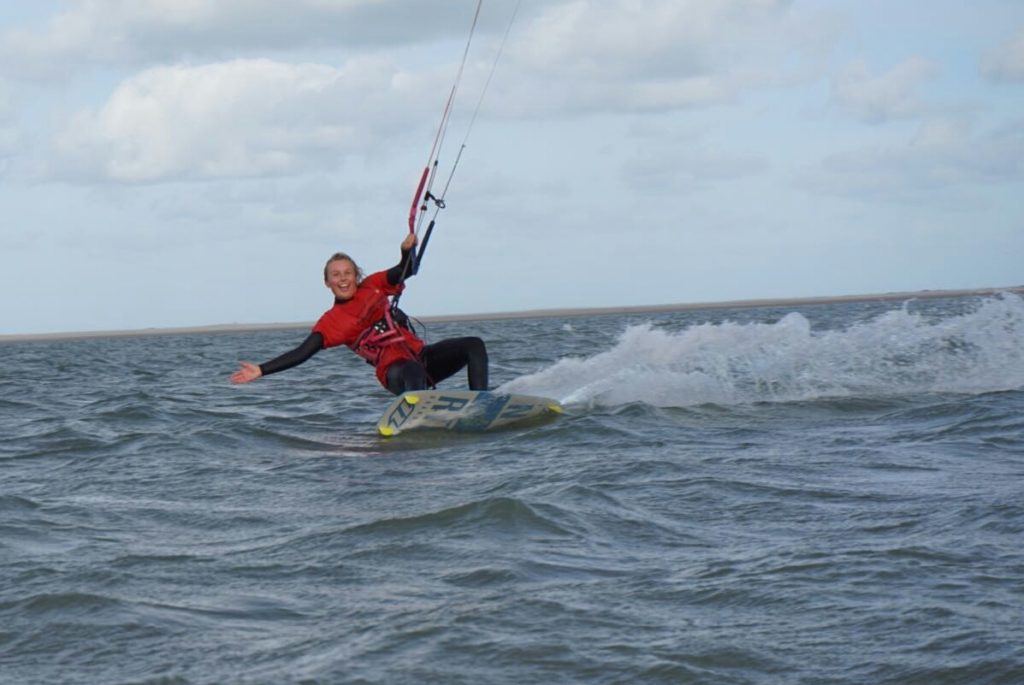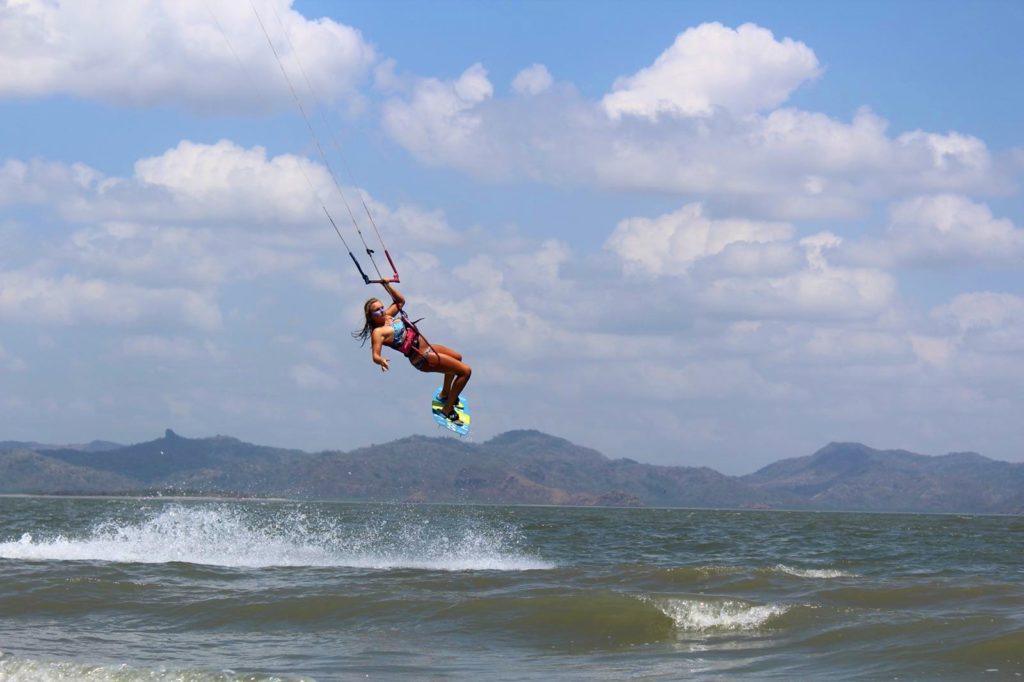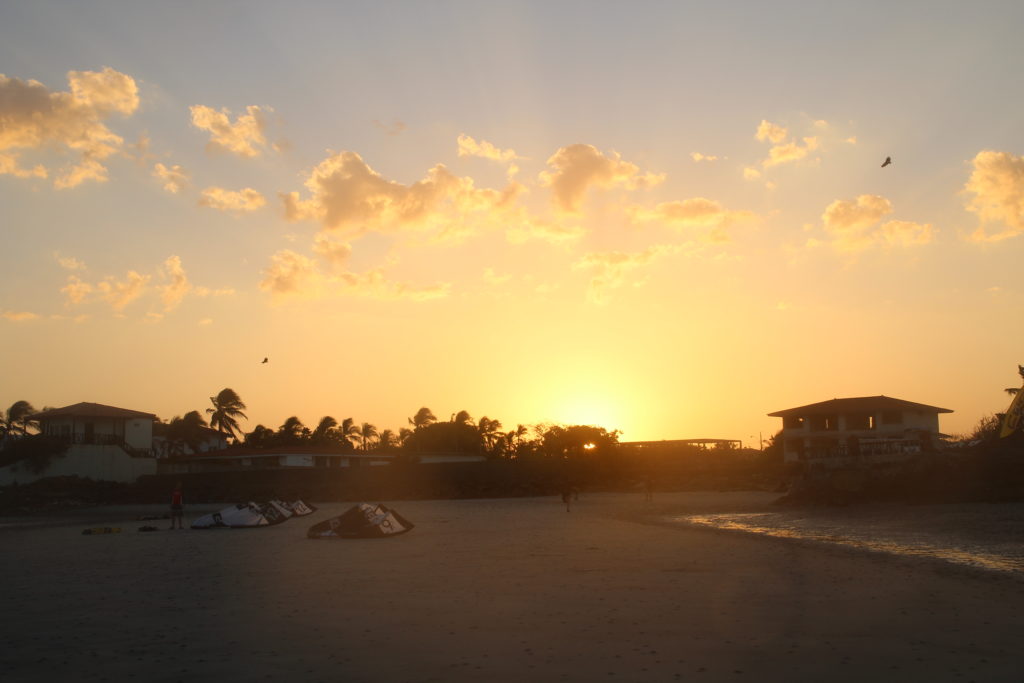
To become a kitesurf instructor you need to be riding for at least a year and be of a certain level (be able to do a jump with a grab, ride toeside, do a jibe and a board recovery) and you need to have completed an instructor course(with a theory exam) at a kiteboarding association such as IKO, VDWS or BKSA. You also need to have completed a first aid course. Then you have to find a school to work for or start your own school to start teaching.
What level do you need to be at to become a kitesurf instructor?
There are several organizations who have different courses to become an instructor. IKO is the most known international organization when it comes to kiting. For the IKO assistant course you need level 4 – advanced to do the course and have at least one year experience. That means being able to ride upwind, do a jump with a grab, a jump transition, a jibe, a rider and board recovery. You also need to be 16 years old and for the full IKO instructor course you need to be at least 18.
For the PASA Instructor course you have to be PASA – level 3 which means that you have to be able to consistently go upwind, perform advanced turns and transitions under power, maintain control in most wind conditions and perform simple jumps. The other organizations have similar requirements, just little differences like with the Watersportverbond you can start teaching at 17 already.
How much does it cost to become a kitesurf instructor? Which courses are available?
It varies between organisations and probably also per location where you can do the courses.
- IKO Assistant and Instructor course (International) is the most expensive one, the most available and internationally recognized. Price AITC: 530 and ITC: $920 (in NL, it probably differs per location worldwide). The courses are 10 days in total. You need to have completed both courses before you can teach on your own.
- Watersportverbond (Dutch) Assistant course: $200 and Instructor course $600. 10 days in total and you need to have completed both before you can teach on your own.
- The PASA ICP (US) is $500. There is just one course and it is 5 days in total.
There are also the French (FFVoile) and German (VDWS) organizations. My French and German isn’t good enough. If you know how this works and how much it is, let me know in the comments 🙂
My Experience
I had only been kiting for a few months when my future boss asked me if I started doing jumps already. When I told him that I did, he asked if I would like to become an instructor. There would be a kitesurf instructor course in June next year. I remember laughing and asking whether I would have enough experience since I would then be kitesurfing for only a year. My boss told me that I just needed a year of experience and that I needed to be able to ride toeside and jump with a grab.
I was super excited but I didn’t have the money to pay for the course, so my boss offered to pay for it and that I would pay him back when I started working at his school. I was 18 at the time, still in my last year of high school and STOKED.
The Courses
I did my IKO Assistant and Instructor course both in two weeks in June in the Netherlands. I loved the courses, to really go in depth and learn not only about how to teach, but also a lot about kitesurfing and the kite which I didn’t even know that much about. You get a book with information for both courses, the material is discussed in class, you have to give some presentations and do a theory exam in the end. We had to learn about the basics of aerodynamics, about the tide, lesson structure, safety, how to launch from a boat, how to give feedback to students, possible scenarios of students doing something wrong etc.
We were with a group of 5 students and also had to practice teaching by role playing some lessons. First one was the student and the other the instructor and then we had to switch. At some point we also got some real students (who got lessons for free, or paid a small amount). I still didn’t really know what to do although you do get a lesson plan of what the students must be able to do before getting to the next exercise, but it just takes a lot of practice to give a good lesson.
I passed the theory exams with ease, they are not that difficult if you use some common sense. But I remember that my kitesurfing skills were not that great yet, (I could only do a grab if I jumped from a kicker) because the instructor told me to keep practicing and then I will be fine as an instructor.

First Lessons
I remember feeling so sorry for my students, “ they have me as their instructor…” When I had to teach my first lessons and didn’t know what I was doing. I also remember keeping notes on my phone with the structure of each lesson which looked something like:
- Introduce yourself + ask experience + tell what we’re going to do this lesson
- Theory wind window + explain upwind/downwind + do a spot assessment
- Let students pump the kite (mention leading edge + struts)
- Let student walk out the lines + connect them to kite
- Flight simulation + safety explanation
- Show how to launch kite, let them show me how to hold the kite
- Launch kite (me)
- Trim kite + explain wind window again using kite
- Let them fly, hold kite still at each number of wind window
- Practice letting go of the bar
… more flight exercises, than body drag exercises, steady pull, explain waterstart etc.
I used to read it before every lesson so I didn’t forget anything. But once you get more experience it becomes very logical what the next steps are and which steps you need to repeat or can skip. I wasn’t a natural teacher I would say, but now I can confidently say I am a good instructor, I can calm nervous students down, mostly pick the right equipment and can give the right feedback most of the time to help my students progress.
What makes a good instructor?
- Someone who has clear communication. So instead of saying “a little bit less power”, say “sheet the bar out”, instead of saying “send the kite from 2 to 10” say “first send the kite to 2, then stop, then slowly to 12, and then to 10” to prevent beginners from steering the kite to aggressively. Also, make clear agreements with the student when they have to walk back or stop somewhere.
- Someone who is patient. Some students (mostly people who are a bit older) just have a really hard time understanding the kite and are struggling with the kite control. You have to be able to stay calm and explain what they have to do over and over again until they develop a feeling for it.
- Someone who can pick the right kite and board size and doesn’t forget to check the wind and weather forecasts. Check the forecast before every lesson to prevent surprises and maybe pump up an extra kite already at the beginning of the lesson so you can switch easily if the wind is predicted to drop or pick up during the lesson.
- Someone who asks the right questions and listens to their students. Maybe it’s their first kite lesson, BUT they have wakeboarded their whole life and flown a kite since they were little. You can adjust the program, go faster through some steps and skip some. If you ask the right questions you also know when to make the lesson just about having fun and when to be more serious and transfer all your knowledge. Some students book a try-out lesson and just want a fun experience and then never really learn the sport, so you don’t want to bore them with information they are not going to use.

Would I recommend becoming a kitesurf instructor? The pro’s and con’s
Pro’s
- Travel
The big pro is that you have the ultimate travel job. You can earn some money while you stay abroad and work while at the kitespot. And after lessons you can go kiting yourself.
- You’re Outside the Whole Day
The thing I love about teaching kitesurfing, rather than working in a bar, is that you can be outside the whole day. You hear the wind, maybe the waves and see the sand and stand in the water. Way better than working in a restaurant with loud guests everywhere.
- Money
Especially when you teach as a side job, the money is pretty good ( it won’t make you rich, though). And there is a lot of effort and responsibility that you have to give in return.
- You Get to Know a Lot of People at the Kite Spot
Because kitesurfing can be a solo sport, teaching is a great way to meet local kitesurfers and other people at the spot where you’re teaching.
- Get People STOKED About Kitesurfing
Sharing the stoke is super fun. You meet students who are very enthusiastic and you can give them their first experiences with this amazing sport. It’s really cool to help people progress in the sport you love and to see so many new people enjoying it.
- You Learn a Lot About Kitesurfing
When you teach kitesurfing you’ll learn new things about what people do wrong while kiting and how you can fix it. You get asked questions a lot and you’ll know how to answer them in no time.
- You Can Try Out New Stuff from the Kite School (Especially cool if they have a shop as well)
At the kiteschool where I teach there is also a shop connected to the school and instructors can try out a lot of new stuff such as wings, boards or light wind kites or even wind surf gear if you would like to try that. With many kiteschools instructors can use the material for free if it is not used during lessons.
- Teaching Skills are Transferable
Teaching kitesurfing is one thing, but once you get the hang of teaching you can also apply it to teach anything else. If you want to learn to teach snowboarding for example, you need to learn the snowboard specifics but you already know how to teach and explain something, how to tailor a lesson to the students needs and how to give feedback.
Con’s:
- Less Kitesurfing Yourself
This is the greatest con: when there is the best wind and you want to be on the water yourself, you probably have to teach. So expect to be kiting less. Even if you don’t have a lesson you might be tired from giving lessons (because teaching can be quite exhausting) so you can expect to have less time and/or energy for kiting.
- Wind Dependent
Teaching kitesurfing can only be done if there is enough wind and not too much wind. So pick a location wisely. Not all locations have very predictable wind and you might end up giving less lessons than expected.
- Seasonal
In most places the kite season is seasonal, so money only comes in in the summer. If it’s your full time job you might end up living in one place for half a year and then another place for the other half. I also know some people who teach kitesurfing in summer and snowboarding in winter.
- Responsibility
Once you are a kite instructor you might feel the responsibility at every spot to help people and you notice when people are doing things wrong. You might feel responsible to make sure everything is going well and people do not make mistakes with safety.
How much do you earn as a kitesurf instructor?
In the Netherlands I started out with 14 euros an hour and currently work as a freelancer for 25 euros an hour. Most schools will pay 10-35 % of whatever they ask for their kite lessons. In addition some kite schools offer perks like being able to use their equipment, paying for accommodation, offering food or paying for your flight.
Tips for choosing a school
- Find a school with plenty of students (to make sure you can teach some hours everyday)
- Find a school with reliable wind and weather (to make sure you can teach some hours everyday)
- Check if you’ll be working freelance or with a paid salary
- Ask for the perks, do they pay for accommodation, food and/or flights?

Kitesurfing can be taught as a side income next to university, but it can also be a full time job. In this case it will not make the most money (maybe 1000-2000 dollars), but it is more about the lifestyle of travel and kitesurfing. Enjoying life at the beach all around the world! 🙂
